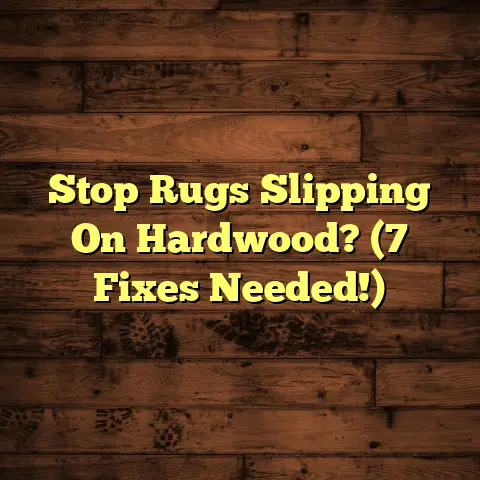Who Cleans Hardwood Floors? (9 Must-Know Tips!)
Introduction: The Transformation of Your Hardwood Floors
Imagine stepping into your living room.
The warm glow of the setting sun catches the polished surface of your hardwood floors, reflecting light back into the room.
Remember when they were dull, scuffed, and hiding under a layer of dust and grime?
Now, they gleam, radiating a sense of cleanliness and sophistication that elevates the entire space.
It’s not just about appearances; it’s about creating a welcoming atmosphere for family and friends.
A properly cleaned hardwood floor does exactly that.
But achieving this transformation requires more than just a quick swipe with a mop.
It demands understanding, the right techniques, and knowing who is best equipped for the job.
So, who does clean hardwood floors, and how can you ensure a flawless finish every time?
Let’s dive in and unlock the secrets to maintaining your hardwood floors’ natural beauty and longevity.
Section 1: Understanding Hardwood Floors
Okay, before we even think about cleaning, let’s get grounded in the basics.
Not all hardwood floors are created equal, and their unique differences affect how we clean them.
Think of it like this: you wouldn’t use the same shampoo on a poodle as you would on a Great Dane, right?
Same principle applies here.
First, you need to know if you have solid hardwood or engineered hardwood.
Solid Hardwood: These are planks made from a single piece of wood.
They’re durable and can be refinished multiple times, but are more susceptible to moisture damage.
Engineered Hardwood: This consists of a thin layer of real hardwood bonded over a core of plywood or fiberboard.
It’s more stable in humid environments, but can only be refinished a limited number of times (or not at all!).
Then there’s the finish.
Surface Finishes (Polyurethane, Polyacrylic): These create a protective layer on top of the wood.
They’re durable and water-resistant, but can be scratched.
Penetrating Finishes (Oil-Based, Wax): These soak into the wood, enhancing its natural beauty.
They require more maintenance and are less water-resistant.
And finally, the type of wood matters too.
Oak is a popular, durable choice, while maple is harder and has a smoother grain.
Cherry is known for its rich color, and exotic woods like Brazilian walnut require specialized care.
| Wood Type | Hardness (Janka Scale) | Cleaning Considerations |
|---|---|---|
| Red Oak | 1290 | Durable, but avoid excessive water |
| White Oak | 1360 | More water-resistant than red oak |
| Maple | 1450 | Prone to showing scratches; use gentle cleaners |
| Cherry | 950 | Softer wood; avoid harsh chemicals |
| Brazilian Walnut (Ipe) | 3680 | Extremely durable; can handle stronger cleaners |
Source: National Wood Flooring Association (NWFA)
Generally, hardwood floors need regular sweeping or vacuuming to remove dirt and debris.
They also need occasional mopping with a pH-neutral cleaner designed specifically for hardwood.
Avoid using excessive water, which can seep into the seams and cause warping or damage.
Understanding these basics is crucial because it determines the best cleaning approach.
Would you agree that knowing your floors is the first step to keeping them pristine?
Section 2: Who Cleans Hardwood Floors?
Now for the big question: Who’s responsible for keeping these beauties clean?
The answer isn’t always straightforward, and it depends largely on your lifestyle, budget, and tolerance for elbow grease.
Let’s break down the key players:
-
Homeowners:
The buck often stops with you.
As a homeowner, you’re the primary caretaker of your floors, which means regular sweeping, vacuuming, and occasional mopping.
Many homeowners use readily available cleaning products from the grocery store, but it’s important to choose wisely.
I’ve seen too many floors damaged by harsh chemicals or excessive water.
Regular upkeep is key – a quick sweep every few days can prevent dirt buildup and minimize the need for intensive cleaning later on.
But let’s be honest, life gets busy.
Sometimes, despite your best intentions, your floors might need more than you can offer.
-
Professional Cleaners:
This is where the cavalry arrives.
Professional cleaning services range from specialized hardwood floor cleaners to general cleaning companies that offer hardwood floor care as part of their services.
Specialized Hardwood Floor Cleaners: These guys are the experts.
They have the knowledge, experience, and specialized equipment to handle even the most challenging cleaning situations.
They often use truck-mounted cleaning systems that extract dirt and grime without leaving behind excess water.
Plus, they know the ins and outs of different finishes and can recommend the best products and techniques for your specific floors.
General Cleaning Companies: These companies offer a broader range of services, including hardwood floor cleaning.
While they may not have the same level of expertise as specialized cleaners, they can still provide a thorough cleaning and are often a more affordable option.
When choosing a professional cleaner, always ask about their experience with hardwood floors, the products they use, and their cleaning process.
Don’t be afraid to ask for references or check online reviews.
-
DIY Enthusiasts:
Ah, the DIY route.
For some homeowners, cleaning hardwood floors is a labor of love.
They enjoy the satisfaction of tackling the job themselves and saving money in the process.
There’s a wealth of information available online, from blog posts to YouTube tutorials, that can guide you through the process.
But proceed with caution!
DIY cleaning can be effective if you’re diligent, use the right products, and follow instructions carefully.
However, it can also be risky.
Using the wrong products, applying too much water, or neglecting to properly dry the floors can lead to damage.
I’ve seen homeowners strip the finish off their floors or cause warping by using harsh chemicals or steam cleaners.
If you’re going the DIY route, start with a small, inconspicuous area to test your cleaning method before tackling the entire floor.
-
Maintenance Staff:
If you live in an apartment complex or commercial building, the responsibility for cleaning hardwood floors may fall to the property management or maintenance staff.
In these cases, the cleaning is often part of a regular maintenance schedule.
However, the level of care can vary widely.
Some maintenance staff are well-trained and use appropriate cleaning methods, while others may simply use a generic cleaning solution and a mop.
If you’re concerned about the care of your hardwood floors, don’t hesitate to communicate with your property management and inquire about their cleaning procedures.
You can even suggest specific products or techniques that you believe would be beneficial.
So, who cleans hardwood floors?
It’s a mix of homeowners, professionals, DIY enthusiasts, and maintenance staff, each with their own role to play.
The key is to understand your own capabilities, the needs of your floors, and to choose the right approach for achieving a flawless finish.
Section 3: Essential Tips for Cleaning Hardwood Floors
Alright, let’s get down to the nitty-gritty.
Here are nine must-know tips for cleaning hardwood floors effectively, based on my years of experience in the flooring industry:
-
Choosing the Right Cleaning Products:
This is where many people go wrong.
Using the wrong cleaning products can damage your hardwood floors, dull the finish, or even void your warranty.
Avoid using harsh chemicals like bleach, ammonia, or vinegar, which can strip the finish and dry out the wood.
Instead, opt for pH-neutral cleaners specifically designed for hardwood floors.
These cleaners are gentle yet effective at removing dirt and grime without causing damage.
I personally recommend Bona Hardwood Floor Cleaner, which is widely available and safe for most hardwood finishes.
You can also make your own DIY cleaner by mixing a small amount of mild dish soap with water, but be sure to use it sparingly and dry the floors thoroughly afterward.
-
Regular Dusting and Sweeping:
Prevention is always better than cure.
Regular dusting and sweeping can prevent dirt buildup and scratches, minimizing the need for more intensive cleaning.
Use a microfiber mop or a soft-bristled broom to remove dust, dirt, and pet hair.
Microfiber mops are particularly effective because they trap dirt and dust without scratching the floor.
I recommend sweeping or dusting your hardwood floors at least once a week, or more frequently if you have pets or live in a dusty environment.
-
Mopping Techniques:
Mopping is essential for removing stubborn dirt and grime, but it’s important to use the right technique.
Avoid using soaking wet mops, which can saturate the wood and cause warping or damage.
Instead, use a damp mop and wring it out thoroughly before applying it to the floor.
Mop in the direction of the wood grain, and work in small sections, overlapping each pass slightly.
Dry the floors immediately after mopping with a clean, dry towel to prevent water spots and streaks.
I find that using a spray mop with a microfiber pad is a convenient and effective way to mop hardwood floors.
-
Spot Cleaning Stains:
Accidents happen.
Whether it’s a spilled glass of wine or a pet accident, it’s important to address stains promptly to prevent them from setting.
For most stains, a damp cloth and a mild cleaning solution will do the trick.
For tougher stains, you may need to use a specialized stain remover designed for hardwood floors.
Pet Accidents: Clean up the mess immediately and use an enzymatic cleaner to neutralize odors and prevent staining.
Food Stains: Blot up the spill with a clean cloth and then use a damp cloth and a mild cleaning solution to remove any residue.
Scuff Marks: Use a tennis ball or a clean eraser to gently rub away scuff marks.
Always test any cleaning solution on a small, inconspicuous area before applying it to the entire stain.
-
Professional Deep Cleaning:
Even with regular cleaning, your hardwood floors may benefit from a professional deep cleaning periodically.
Professional deep cleaning can remove embedded dirt and grime, restore the shine to your floors, and extend their lifespan.
I recommend scheduling a professional deep cleaning every 12-18 months, especially for heavily trafficked areas.
Professional cleaners use specialized equipment and cleaning solutions to thoroughly clean your floors without causing damage.
They can also apply a fresh coat of finish to protect your floors and enhance their appearance.
-
Preventive Measures:
The best way to keep your hardwood floors clean is to prevent them from getting dirty in the first place.
Use Rugs in High-Traffic Areas: Place rugs in entryways, hallways, and other high-traffic areas to protect your floors from dirt and wear.
Wear Socks Instead of Shoes Indoors: Encourage family members and guests to remove their shoes when entering your home.
Use Furniture Pads: Attach felt pads to the bottom of furniture legs to prevent scratches and dents.
Clean Up Spills Immediately: Don’t let spills sit on your floors for extended periods of time.
-
Humidity Control:
Hardwood floors are susceptible to changes in humidity.
Excessive humidity can cause the wood to swell and warp, while low humidity can cause it to shrink and crack.
Maintain a consistent humidity level in your home, ideally between 30% and 50%.
Use a humidifier during the dry winter months and a dehumidifier during the humid summer months to regulate the humidity levels.
I’ve seen too many beautiful hardwood floors ruined by neglecting humidity control.
-
Refinishing vs. Cleaning:
There comes a time when cleaning is no longer enough.
If your hardwood floors are heavily scratched, worn, or discolored, it may be time to consider refinishing.
Refinishing involves sanding down the existing finish and applying a new coat of finish.
This can restore your floors to their original beauty and extend their lifespan.
However, refinishing is a significant undertaking and should be done by a professional.
Signs that indicate the need for refinishing include:
Deep Scratches and Gouges Worn or Discolored Finish Water Damage Loss of Shine
-
Educating Others:
Finally, educate your family members and guests on proper maintenance to ensure continued cleanliness and care for your hardwood floors.
Let them know the importance of removing shoes, cleaning up spills promptly, and avoiding harsh chemicals.
By working together, you can keep your hardwood floors looking beautiful for years to come.
Conclusion: Embracing a Clean Home Environment
Cleaning hardwood floors is more than just a chore; it’s an investment in your home’s beauty, value, and your family’s health.
By understanding the different types of hardwood floors, knowing who is responsible for cleaning them, and following these nine essential tips, you can achieve a flawless finish every time.
Remember, regular care and proper techniques are key to maintaining your hardwood floors’ natural beauty and longevity.
Take pride in your hardwood floors, knowing that with a little effort, you can enjoy their transformation for years to come.
And that’s the beauty of a well-maintained home environment.





